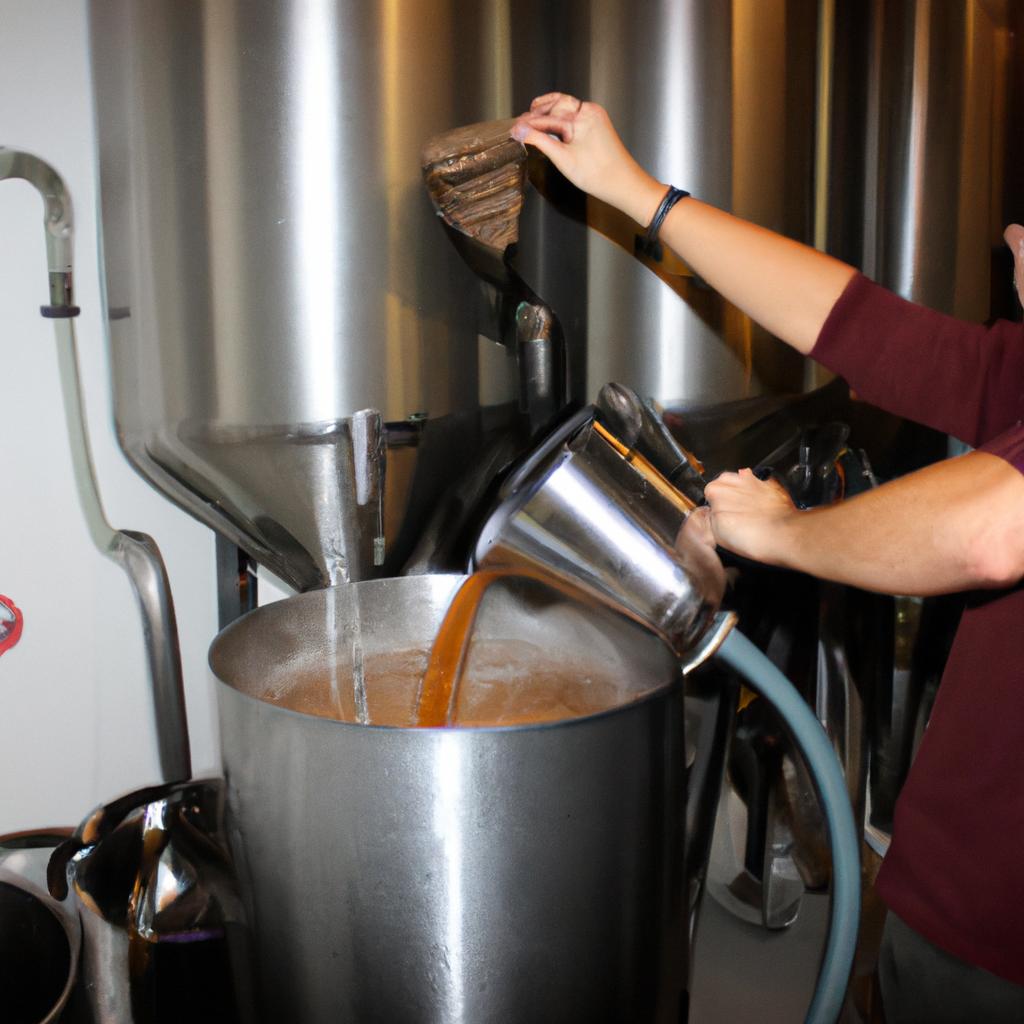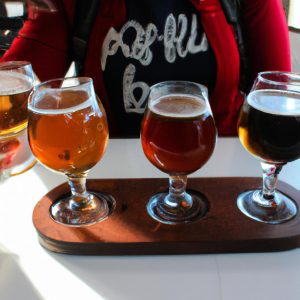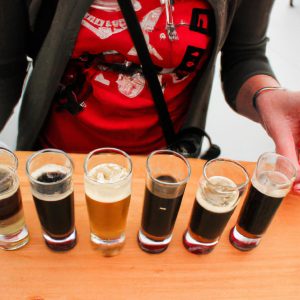Brewing Techniques: Craft Beer Varieties

Brewing techniques play a pivotal role in the creation of craft beer varieties, as they determine the flavors, aromas, and overall quality that are characteristic of each unique brew. The art of brewing has evolved over centuries, with modern advancements allowing for an extraordinary range of creative possibilities. To illustrate this point, let us consider the case study of a hypothetical craft brewery known as “Hop Haven.” Through meticulous attention to detail and innovative brewing methods, Hop Haven has managed to produce a diverse array of craft beers that have captivated the palates of beer enthusiasts worldwide.
Craft beer is defined by its emphasis on small-scale production, traditional ingredients, and distinctive flavor profiles. This commitment to craftsmanship extends to every facet of the brewing process – from ingredient selection and malt preparation to fermentation temperatures and aging techniques. Each step influences the final product’s character and contributes to its uniqueness within the vast landscape of craft beer offerings. By exploring different brewing techniques, brewers can experiment with various combinations of ingredients, adjust variables such as hop additions or yeast strains, and employ alternative processes like barrel aging or dry hopping to create truly exceptional brews that cater to even the most discerning consumer preferences.
In this article, we will delve into the world of brewing techniques used in crafting distinct flavors, aromas, and textures in craft beer. These techniques include:
-
Mashing: This process involves steeping malted grains in hot water to extract sugars, flavors, and colors. Brewers can manipulate the temperature and duration of mashing to achieve different levels of sweetness, body, and mouthfeel in their beers.
-
Boiling: After mashing, the liquid known as wort is boiled with hops to impart bitterness, aroma, and flavor. The timing and quantity of hop additions during boiling greatly influence the final beer’s hop profile.
-
Fermentation: During fermentation, yeast consumes the sugars in the wort and produces alcohol and carbon dioxide. Brewers can choose different yeast strains to create unique fermentation characteristics such as fruity esters or spicy phenols.
-
Dry Hopping: This technique involves adding hops directly to the fermenter after primary fermentation is complete. It enhances aroma without adding significant bitterness by extracting volatile compounds from the hops.
-
Barrel Aging: Some craft breweries age their beers in barrels previously used for spirits or wine. This process imparts complex flavors from the wood and any residual spirits or wine that may have soaked into it.
-
Souring Techniques: Certain beer styles like sour ales are intentionally brewed with bacteria or wild yeast strains to produce tartness or acidity. Techniques like kettle souring or barrel aging with specific microorganisms contribute to these unique flavors.
-
Adjuncts and Special Ingredients: Craft brewers often experiment with adjuncts such as fruits, spices, coffee beans, chocolate, or even unconventional ingredients like seaweed or flowers to add complexity and distinctiveness to their brews.
8.Cold Conditioning: Also known as lagering, this technique involves storing beer at near-freezing temperatures for an extended period after primary fermentation has completed. It helps clarify the beer while allowing flavors to meld together smoothly.
These are just a few examples of brewing techniques employed by craft brewers to create a wide range of flavors, aromas, and overall sensory experiences in their beers. The artistry lies in knowing how to balance and combine these techniques to achieve the desired result. Through continuous experimentation and innovation, craft breweries like Hop Haven push the boundaries of what is possible in the world of beer brewing, delighting enthusiasts with their unique creations.
Pale Ales
Pale Ales
Imagine yourself sitting at a cozy pub, sipping on a refreshing pint of beer. The golden hue catches your eye as you take in the enticing aroma of hops and malt. This is the world of pale ales – a diverse category that encompasses everything from light and crisp to bold and hop-forward brews.
One example of a popular pale ale style is the American Pale Ale (APA). With its moderate alcohol content and balanced flavor profile, APAs have become a staple in craft breweries across the United States. These beers often showcase citrusy and piney hop characteristics with just enough malt sweetness to provide balance.
To truly appreciate the nuances of pale ales, let’s explore some key aspects that make them so captivating:
- Hop Varieties: Pale ales offer an incredible range of hop flavors and aromas, contributing to their distinct character. From floral and fruity notes to herbal or resinous undertones, each variety adds its own unique twist to these beers.
- Malt Profiles: While hops steal much of the limelight, malt plays an essential role in pale ales by providing body, color, and subtle sweetness. Different types of malts can create variations ranging from biscuity and caramel-like flavors to more grainy or bready profiles.
- Food Pairings: Whether it’s spicy buffalo wings or grilled salmon fillets, pale ales effortlessly complement various dishes. Their bright hop bitterness cuts through rich flavors while enhancing savory elements like cheese or charred meats.
- Seasonal Appeal: Pale ales are versatile for every season. During warmer months, lighter versions such as Blonde Ales refreshingly quench thirsts. In contrast, robust India Pale Ales (IPAs) evoke feelings of warmth during colder seasons.
Consider this table showcasing different subcategories within the realm of pale ales:
| Subcategory | Flavor Profile | ABV Range |
|---|---|---|
| American Pale Ale | Citrus, piney hop notes | 4.5% – 6.2% |
| English Bitter | Balanced malt and hop profile | 3.8% – 4.6% |
| Belgian Blond | Spicy yeast, fruity esters | 6.0% – 7.0% |
| New England IPA | Juicy, hazy with low bitterness | 6.0% – 7.5% |
As we delve into the fascinating world of India Pale Ales (IPAs), prepare yourself for an exploration of bolder flavors and higher hop intensity that will further captivate your taste buds.
India Pale Ales (IPAs)
Section H2: India Pale Ales (IPAs)
India Pale Ales, commonly known as IPAs, have gained significant popularity in the craft beer industry. These hop-forward beers are characterized by their strong and assertive flavors that appeal to adventurous beer enthusiasts. To understand the distinctiveness of IPAs, let’s explore their brewing techniques and unique characteristics.
Imagine a scenario where you walk into a bustling taproom filled with IPA lovers eagerly discussing different flavor profiles. One particular brew stands out – a hazy IPA infused with tropical fruit notes, showcasing the creative use of hops. This example highlights how brewers experiment with various ingredients and brewing methods to create diverse variations within the IPA category.
When it comes to brewing IPAs, several key factors contribute to their signature taste:
- Hop Selection: Brewers carefully choose specific hop varieties known for their aromatic qualities and high alpha acid content. Popular choices include Cascade, Citra, Simcoe, Amarillo, or Mosaic hops.
- Dry Hopping: In addition to adding hops during the boiling process like traditional beers, IPAs often undergo dry hopping. This technique involves introducing additional hops during fermentation or post-fermentation stages to enhance aroma without increasing bitterness.
- Bitterness Balance: While IPAs are known for their bitter bite, achieving harmony between malt sweetness and hop bitterness is crucial. The right balance ensures that the intense hop character does not overpower other flavors but rather complements them.
- Yeast Strains: Different yeast strains can influence an IPA’s overall profile. Some yeasts produce fruity esters that accentuate hop aromas while others may emphasize clean fermentation resulting in a crisper finish.
To illustrate further differences among IPA substyles based on alcohol content and color intensity, consider the following table:
| Substyle | Alcohol Content | Color |
|---|---|---|
| Session IPA | Low | Light |
| West Coast IPA | Moderate to High | Amber |
| Double/Imperial | High | Golden to Dark |
| New England IPA | Moderate | Hazy, Pale Straw |
This table demonstrates the range of IPAs available, from sessionable options with lower alcohol content and lighter colors to more robust double or imperial IPAs with higher ABV levels and darker hues.
Transitioning into the subsequent section on Stouts and Porters, we embark upon a different beer journey. While IPAs captivate enthusiasts seeking hop-forward experiences, stouts and porters offer rich malty flavors that satisfy those craving complexity in their brews. Let’s explore these dark beers’ unique characteristics and brewing techniques.
[Next Section: H2 – Stouts and Porters]
Stouts and Porters
Building on the diverse range of flavors and brewing techniques explored in India Pale Ales (IPAs), let us now delve into another popular category of craft beers – Stouts and Porters. These rich, dark brews offer a unique sensory experience that is loved by beer enthusiasts worldwide.
Stouts and porters are renowned for their deep, roasted malt flavors and velvety smooth textures. To illustrate this, imagine savoring a robust stout with notes of coffee, chocolate, and caramel. The complex interplay between these flavors creates a harmonious taste profile that lingers on the palate long after each sip.
To better understand the characteristics of stouts and porters, consider the following bullet points:
- Dark Appearance: Stouts and porters exhibit an opaque black coloration due to the use of heavily roasted malts.
- Roasted Malt Flavor: The extensive roasting process imparts distinct flavors reminiscent of coffee, cocoa, or even charred wood.
- Full-Bodied Texture: These beers often have a thick mouthfeel that coats the tongue with richness.
- Lower Carbonation Levels: Compared to other styles, stouts and porters tend to have lower levels of carbonation, contributing to their smoother texture.
In addition to their flavor profiles, it is worth mentioning some notable differences between stouts and porters in a table format:
| Stout | Porter | |
|---|---|---|
| Color | Typically darker than porters | Can vary from brown to black |
| Origin | Historically associated with Ireland | Developed in England |
| ABV | Higher alcohol content ranging from 5% to well over 10% | Generally lighter with alcohol content around 4% to 6% |
| Use | Often utilized as base beers for various barrel-aged variants | Adaptable style allowing for experimentation with different flavors |
In conclusion, stouts and porters offer a captivating departure from the hop-forward intensity of IPAs. These beers possess a certain depth and complexity that appeals to those seeking a more robust flavor experience. Moving forward, we will explore another intriguing style – Wheat Beers, which provide a refreshing contrast to the dark richness discussed here.
Wheat Beers
Moving on from the rich and robust flavors of stouts and porters, we now delve into the refreshing world of wheat beers. These beers are known for their lightness and smooth mouthfeel, making them a favorite among many beer enthusiasts.
Wheat beers are brewed with a significant proportion of malted wheat in addition to barley malts. This combination results in a distinct flavor profile that is often characterized by notes of banana, clove, and citrus. One example of a popular wheat beer style is the German Hefeweizen, which showcases these fruity and spicy characteristics.
When it comes to brewing techniques for wheat beers, several key factors contribute to achieving the desired flavor profile:
-
Mashing: The mashing process plays a crucial role in extracting fermentable sugars from the grains. For wheat beers, brewers typically employ a step mash technique wherein multiple temperature rests are used to activate various enzymes responsible for breaking down complex carbohydrates into simpler sugars.
-
Yeast Selection: Choosing the right yeast strain is essential in bringing out the distinctive aromas and flavors associated with wheat beers. Brewers often opt for strains that produce esters and phenols during fermentation, contributing to the fruity and spicy notes commonly found in these styles.
-
Fermentation Temperature: Maintaining an appropriate fermentation temperature is crucial for achieving optimal flavors in wheat beers. Higher temperatures can enhance ester production, resulting in more pronounced fruitiness, while lower temperatures can promote cleaner profiles with fewer off-flavors.
-
Carbonation Levels: Wheat beers often exhibit higher carbonation levels compared to other beer styles. This effervescence contributes to their refreshing nature and enhances their overall drinkability.
- Crisp and refreshing.
- Perfect summer beverage.
- Pairs well with lighter fare such as salads or seafood.
- Offers a wide range of flavor possibilities like citrusy or spiced varieties.
Markdown Table:
| Flavor Profile | Example Beers | Aroma |
|---|---|---|
| Citrusy | American Wheat Beer | Zesty, bright |
| Spiced | Belgian Witbier | Clove, coriander |
| Fruity | German Hefeweizen | Banana, bubblegum |
| Tart | Berliner Weisse | Sour apple, lemonade-like |
As we explore the diverse world of craft beer varieties, our next stop takes us to the intriguing realm of sour beers. These unique brews offer a tangy and tart experience that captivates the taste buds in unexpected ways.
Sour Beers
Section H2: Sour Beers
Sour beers are a fascinating category of craft beer that has gained significant popularity in recent years. These unique brews are characterized by their distinct tart and acidic flavors, which are achieved through various fermentation techniques. One intriguing example is the Lambic style from Belgium, where wild yeasts and bacteria naturally ferment the beer for an extended period, resulting in complex sour notes.
To fully appreciate the world of sour beers, it is essential to understand the different brewing techniques used to create these exceptional beverages. Here are some key points:
- Blending: Many brewers utilize blending as a technique to achieve desired flavor profiles in sour beers. By combining different batches with varying levels of acidity or fruit additions, they can create harmonious and balanced final products.
- Barrel Aging: Another method commonly employed in crafting sour beers is barrel aging. The use of oak barrels allows for interaction between the beer and the wood, contributing additional layers of complexity and imparting unique flavors.
- Fruit Additions: Adding fruits during fermentation provides both flavor enhancement and natural sugars for further fermentation. This practice adds depth and complexity to many sour beer styles such as Berliner Weisses or Fruited Goses.
- Mixed Fermentation: Sour beers often undergo mixed fermentation, wherein traditional brewing yeast strains coexist with wild yeasts like Brettanomyces and lactic acid bacteria. This combination creates a diverse range of flavors while introducing characteristic funkiness.
Table 1 below showcases some popular types of sour beers along with their defining characteristics:
| Beer Style | Description | Flavor Profile |
|---|---|---|
| Gose | Light-bodied wheat ale with coriander & salt | Tart, Salty |
| Berliner Weisse | Refreshing German-style wheat beer | Crisp, Lively |
| Flanders Red Ale | Aged Belgian ale with complex malt and fruitiness | Tart, Fruity, Vinous |
| American Wild Ale | American take on sour beers | Funky, Complex |
Table 1: Popular Sour Beer Styles
Sour beers offer a unique sensory experience that appeals to adventurous beer enthusiasts. With their diverse range of flavors, from tart and tangy to funky and fruity, they continue to captivate the palates of craft beer aficionados worldwide.
Moving forward, let us delve into the rich realm of Belgian-Style Ales.
Belgian-Style Ales
Brewing Techniques: Craft Beer Varieties
Section H2: Sour Beers
Having explored the fascinating world of sour beers, we now turn our attention to another renowned craft beer style—Belgian-Style Ales. Just as sour beers offer a unique flavor profile that sets them apart from other brews, Belgian-style ales boast their own distinct characteristics and brewing techniques.
Belgian-Style Ales:
To illustrate the diverse range of flavors found within this category, let’s consider the hypothetical example of Brewery X crafting an exceptional Belgian-style ale called “Golden Delight.” This ale showcases the complexity and artistry involved in creating these beloved brews. Now, let us delve into the key aspects that define Belgian-style ales:
-
Yeast Strains:
- Belgian-style ales rely on specific yeast strains known for producing fruity esters and spicy phenols.
- Some notable examples include Saccharomyces cerevisiae (commonly referred to as “Trappist yeast”) and Brettanomyces (known for its wild fermentation qualities).
-
Malt Bill:
- The malt bill used in Belgian-style ales often incorporates specialty malts such as aromatic or biscuit malt to enhance depth of flavor.
- These malts contribute hints of caramel, toastiness, or nuttiness, adding layers of complexity to the final product.
-
Adjunct Ingredients:
- Many brewers add adjunct ingredients like candi sugar or honey during fermentation to increase alcohol content while imparting subtle sweetness.
- Spices such as coriander, orange peel, or even chamomile may also be included to lend additional aroma and flavor notes.
-
Bottle Conditioning:
- Unlike many modern beer styles which are force-carbonated using CO2 tanks, some Belgian-style ales undergo bottle conditioning.
- This traditional method involves fermenting the beer in the bottle, allowing natural carbonation to develop over time and resulting in a lively effervescence.
Table: Belgian-Style Ales Comparison
| Style | ABV Range | Flavor Profile |
|---|---|---|
| Witbier | 4.5% – 5.5% | Citrusy, light-bodied, with hints of coriander |
| Saison/Farmhouse | 6.0% – 8.5% | Spicy and fruity, often with peppery notes |
| Dubbel | 6.0% – 7.6% | Rich maltiness, dark fruit flavors |
| Tripel | 7.5% – 9.5% | Strong yet balanced, complex |
In crafting these distinct brews, brewers aim to create beers that are rich in flavor and steeped in tradition while also pushing the boundaries of innovation. The unique combination of yeast strains, specialty malts, adjunct ingredients, and traditional brewing techniques culminate in Belgian-style ales that captivate the senses and leave a lasting impression on beer enthusiasts worldwide.
By exploring various craft beer varieties like sour beers and Belgian-style ales, we can truly appreciate the artistry behind each pint poured into our glasses—unveiling not only different styles but also glimpses into the diverse cultures from which they originate. So raise your glass to this ever-evolving world of craft beer as it continues to surprise and delight us with its endless possibilities.



